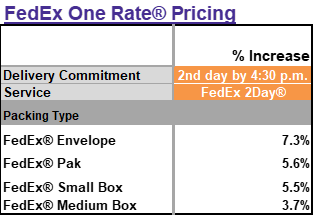In perhaps the parcel industry’s most dynamic year to date, yet another pricing increase has been announced before the official start of peak season. Effective November 2, 2020, FedEx will be increasing One Rate 2Day pricing.
What Is FedEx One Rate?
Offered as a contract-only flat rate pricing option, FedEx One Rate targets infrequent and low volume Express shippers that prefer unlimited weight products at predictable rates. Designed to compete with UPS Simple Rate and USPS Priority Mail FlatRate, One Rate services differentiates itself by providing all Express delivery commitments – including First, Priority, and Standard Overnight to Saver – and 12 sizes of package from envelope to extra large box.
Prices are based on the size of the box and service level desired, with distance-based pricing for zones 2, 3-4, and 5-8 (including AK and HI). Rates can vary greatly, with larger contracts offering the same pricing across all zones. A popular reason to utilize One Rate is any applicable residential, delivery area, and fuel surcharges are included. Value-Add services like Saturday Delivery, additional declared value (above $100), and Delivery Signature options will have additional cost (often discounted in contracts).
Other FedEx One Rate advantages include:
· 12 free express packaging options
· Ability to use own packaging (restrictions apply)
· Multiple time-definite delivery services
· Applies toward earned discounts (EDs)
· Declared Value of $100
What Is the 2Day Increase?
At time of publishing, prices have increased from 3.7% to 7.3% and apply to 2Day Envelope, Pak, Small Box, and Medium Box sizes:

As an example, a 7lb package is shipped to a residential customer within 150 miles (zone 2). Using published FedEx 2Day Air rates, the shipper would pay $23.32 for transportation and $4.65 for residential surcharge. Applicable surcharges like Fuel and Deliver Area (DAS) would further add cost.
If the contents fit in the Small Box, it would ship for $15.57 at the same day-definite delivery.
Why Now?
Explanations from FedEx representatives include the following as primary drivers for the increase:
· Extremely high demand for transportation services due to a change in buying patterns – specifically higher B2C volumes.
· Capacity constraints in the form of people, equipment, and facilities.
· Cost of acquiring such capacity in these three areas has surged due to demand.
The disclosure of increased pricing also included news that no additional rate increase will occur in January 2021.
Who Should Consider FedEx One Rate?
Fixed pricing and free use of premium packaging provide the most value to One Rate shippers with consistently small, dense package profiles in need of day-definite delivery – particularly when recipients are residential or in DAS ZIP Codes.
It is important to consider challenges to reaping the value of One Rate pricing. Incorporating One Rate into Transportation Management Systems (TMS) can be a challenge for shippers because of the unique rules needed to properly integrate with other shipping options for least-cost routing. Additionally, exact packaging specifications must be followed — particularly when it comes to Pak vs Box rates.
Remember, the deluge of changes and increases in the parcel world continues as we enter the peak months of the highest volume year on record. Shippers’ only chance at mitigating cost is through awareness and engaging the industry expertise available.FedEx One Rate can be a competitive option for many shippers, but the devil is in the details. With a wide array of billing facets that can influence final cost, a thorough understanding of your current contract and shipping operation is essential before implementing large volume shifts. Minimum charges, tiered discounts, volume commitments, and accessorials are just a few areas of cost that can have an outsized impact on transportation expenses.
Matt Weickert is a Senior Professional Services and Shipping Consultant for Shipware, a parcel consulting firm that specializes in cost reduction and recovery services. Matt establishes negotiation strategies and tactical pricing options in dealings with UPS, FedEx, DHL, regional parcel carriers, postal consolidators, parcel aggregators, USPS, LTL and other carrier services. Matt is also a world class distance runner and a graduate of Mississippi State University.












